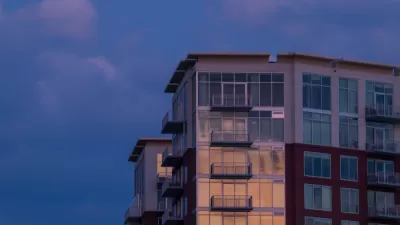Ideally, planners could balance homeowners' interests in zoning against the public good, liberalizing zoning when prices got too high. But this may be politically impossible.

As I and many others have argued (both in Planetizen and elsewhere) existing zoning increases housing costs and accelerates suburban sprawl by restricting the housing supply available in close-in, walkable neighborhoods. It could be argued, however, that planners can both use zoning to slow neighborhood change and keep housing affordable. This would be the case if when rents rose significantly, political pressure to liberalize zoning increased, thus slowing the growth of rent and housing prices. If this were the case, zoning would be self-correcting and thus more defensible.
Some evidence suggests that it's possible to liberalize zoning. For example, in 2018 the Minneapolis City Council voted to allow four-unit dwellings throughout the city, and to upzone some major streets as well. Similarly, in 2019, Oregon began to require cities to allow four-unit dwellings in areas zoned for single-family dwellings, and a few other cities allow accessory dwelling units next to houses. It is too soon, however, to know whether these reforms will significantly increase housing supply.
But evidence from the most expensive cities suggests that rather than leading to saner zoning, high rents actually increase resistance to new housing. In particular, a study by Harvard University fellow Michael Hankinson shows that residents of high-cost cities are actually less pro-housing than other Americans. The Hankinson study was based on numerous surveys of renters and homeowners. One such survey asked a national sample of homeowners and renters about their support for new residential buildings near their homes. The homeowners were significantly less likely to support a new building within 1/8 mile of their homes than a similar building two miles away. By contrast, renters were equally supportive of both types of buildings.
But Hankinson then divided the results by city. Among renters in the most expensive quintile of cities (that is, those with average rent over $2247) the study found that renters, like homeowners, were much less likely to support housing within 1/8 mile of their homes than similar buildings 2 miles away. By contrast, in the least expensive cities, renters were actually more likely to support nearby housing than faraway housing.
A survey of residents of notoriously costly San Francisco revealed more extreme results. The survey asked respondents whether they would support a ban on most market-rate housing within their neighborhood. Sixty-two percent of renters supported the ban, as opposed to only 42 percent of homeowners. Even among renters who supported a citywide increase in housing, 52 percent favored this proposal.
In sum, where rents are high, renters become anti-housing too. Why? One clue is that renters, unlike homeowners, are far more likely to support lower-income housing (also known as "affordable" housing) in their immediate neighborhoods than market-rate housing. The willingness of renters to accept low-income housing suggests that perhaps renter opposition to other housing is driven less by abstract concerns about community character than about fears of displacement by more affluent tenants. Even though renters may believe in the abstract that more housing equals lower rents, the same renters may also believe that a new building in their own neighborhood will a) make the neighborhood more attractive, and thus increase local rents and/or b) will be such a minuscule addition to the citywide housing supply that it will not reduce citywide rents.
Thus, it appears that high rents make anti-housing policies even more popular. This view is also supported by recent political trends in expensive New York City, where political leaders now seem hostile to market-rate housing. For example, Scott Stringer, a leading candidate for mayor, proposes to require that 25 percent of all housing be affordable to lower-income renters in any development with over ten housing units, even if the unit was authorized by existing zoning. Assuming that these "affordable" units would be unprofitable for a developer to build, a developer subject to this policy would have two options: either raise rents on other tenants (which would make housing less affordable for most tenants) or have lower profits. The latter scenario is no doubt unappealing to developers, who as a result may choose to a) build in places with more lenient laws than New York or b) choose to invest their capital in other ways. Thus, Stringer’s proposal is likely to reduce housing supply. The Democratic front-runner, Andrew Yang, is not as hostile to new market-rate housing as Stringer, but does not wish to be seen as promoting such housing either: his web page says that he favors "expanding our affordable housing stock" but does not mention upzoning or other policies that would increase the supply of market-rate housing.
If New York's mayor is somehow incapacitated, the next officeholder in line is the public advocate. Public Advocate Jumaane Williams, like Stringer, supports making upzonings more difficult and time-consuming. In particular, Williams proposes that applicants for significant upzonings create a "racial disparity study." This study would have to include a wide variety of data about the area to be rezoned, such as "eviction filing rates, median household incomes, and median rent and home prices within a half-mile radius of the project area." The study would have to project rents for all residential units created by the rezoning, and would have to identify how the petitioner would mitigate any "identified disparities or displacement risk."
This proposal would build on New York’s State Environmental Quality Review Act (SEQRA), which creates an environmental review process for major rezonings. Under SEQRA, an environmental impact statement (EIS) is required whenever a rezoning would "add a significant number of businesses or housing units." The environmental review process sometimes takes years to complete, because even after an initial EIS is completed, an opponent of a project can challenge the EIS as inadequate, call for a supplemental EIS, or even challenge the supplemental EIS as inadequate. Such delay makes development more expensive, because a developer will often be paying interest on loans during the environmental review process. If the city added a "racial review process" to environmental review, opponents of new housing would be able to spend years challenging developers' racial disparity studies as inadequate, just as they currently challenge environmental impact statements as inadequate. A leading supporter of the proposal admits as much, stating that it would "inject more of the community’s voice in the city’s environmental review process." In other words, it would give "Not In My Back Yard" activists more power to delay projects. Although many rezonings would eventually survive such "racial review," it would nevertheless make housing development more time-consuming and thus more costly.*
In sum, zoning is not self-correcting: some of the most expensive cities seem to be stuck in a vicious circle. High rents create public concern about gentrification and displacement, which in turn leads to more anti-housing regulation, which in turn is likely to lead to even slower growth in housing supply, causing rents to continue to rise in the long run. Thus, the current zoning system might not be able to accommodate consumer demand for less expensive housing.
*The major argument for racial impact studies is that upzonings lead to gentrification and displacement. In particular, supporters of the bill rely heavily on a study by Churches United for Fair Housing, claiming that after a 2005 upzoning, Latino population in two northern Brooklyn neighborhoods declined. But this study is incomplete, for two reasons. First, Latino population had been falling in those neighborhoods since 1990, long before the rezoning. Second, other Brooklyn neighborhoods that did not upzone also become whiter.

Alabama: Trump Terminates Settlements for Black Communities Harmed By Raw Sewage
Trump deemed the landmark civil rights agreement “illegal DEI and environmental justice policy.”

Planetizen Federal Action Tracker
A weekly monitor of how Trump’s orders and actions are impacting planners and planning in America.

The 120 Year Old Tiny Home Villages That Sheltered San Francisco’s Earthquake Refugees
More than a century ago, San Francisco mobilized to house thousands of residents displaced by the 1906 earthquake. Could their strategy offer a model for the present?

In Both Crashes and Crime, Public Transportation is Far Safer than Driving
Contrary to popular assumptions, public transportation has far lower crash and crime rates than automobile travel. For safer communities, improve and encourage transit travel.

Report: Zoning Reforms Should Complement Nashville’s Ambitious Transit Plan
Without reform, restrictive zoning codes will limit the impact of the city’s planned transit expansion and could exclude some of the residents who depend on transit the most.

Judge Orders Release of Frozen IRA, IIJA Funding
The decision is a victory for environmental groups who charged that freezing funds for critical infrastructure and disaster response programs caused “real and irreparable harm” to communities.
Urban Design for Planners 1: Software Tools
This six-course series explores essential urban design concepts using open source software and equips planners with the tools they need to participate fully in the urban design process.
Planning for Universal Design
Learn the tools for implementing Universal Design in planning regulations.
Clanton & Associates, Inc.
Jessamine County Fiscal Court
Institute for Housing and Urban Development Studies (IHS)
City of Grandview
Harvard GSD Executive Education
Toledo-Lucas County Plan Commissions
Salt Lake City
NYU Wagner Graduate School of Public Service






























